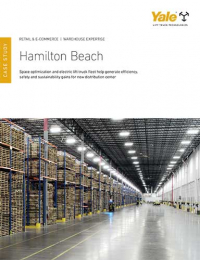IANA reports strong full-year and fourth quarter 2014 performance
Latest Material Handling News
Even with myriad challenges in 2014, including harsh winter weather and the ongoing West Coast port congestion issues, intermodal volumes saw positive gains in 2014, according to the most recent edition of the Intermodal Market Trends & Statistics report from the Intermodal Association of North America (IANA).
Total 2014 intermodal volume—at 16,276,892 containers and trailers––saw a 4.8 percent annual increase compared to 2013. Domestic containers—at 6,444,532—were up 5.7 percent, and international containers—at 8,166,010—were up 4.4 percent. All domestic equipment at 8,110,882—was up 5.1 percent, and trailers rose 2.9 percent to 1,666,350.
For the fourth quarter, total volume—at 4,111,401—was up 3.0 percent compared to the fourth quarter of 2013. Domestic containers were up 5.1 percent at 1,672,332, and international containers—at 2,011,754—were up 2.1 percent en route to leading all intermodal segments for the fourth year in a row and seven of the last eight years. Trailers eked out a 0.1 percent gain at 427,315, and all domestic equipment was up 4.0 percent at 2,099,647.
Based on IANA data, the report observed that 2014 marked the first time in three years that international, domestic containers, and trailers each saw annual gains, while showing the strongest overall intermodal growth since 2011. What’s more, international volume posted its largest annual increase since the economy was emerging from the depths of the recession in 2010, with the 4.4 percent annual growth rate almost double the previous three years, while total international volume was only 4 percent below 2006’s pre-recession peak. And 2014 trailer volume saw its first annual gain in three years, while seeing a 35 percent total decline in the past decade.
IANA officials noted that international growth exceeded expectations in the fourth quarter, with the gains stemming from “stronger than expected container imports.”
As for domestic containers, even though 2014 was up 5.7 percent compared to 2013, it is down from the 9.4 percent increase in 2014 over 2013. Despite the decline in annual growth rate, IANA said that it is not alarming, because domestic container shipments have been growing at a quick clip in recent years, which, in turn, requires a larger volume increase to result in a higher growth rate. On top of that, it added that growth in recent years has been due to intermodal gaining share from trucking, which portends the possibility that future domestic container gains may be smaller.
“If the past is a predictor of the future, then domestic container growth will continue and be the barometer and driver of overall intermodal gains,” said IANA President and CEO Joni Casey. “And railroad service continues to improve and is reflected by the sustainability of domestic intermodal volumes.
Casey added that considering that the overall volume growth rate of 4.8 percent was above 2013, as well as higher than in 2012, 2014 intermodal industry performance modestly exceeded expectations.
As for lower fuel prices, which have dropped significantly in recent weeks, Casey said that the price drop has had little, if any, impact on domestic intermodal volumes.
“Year-end volumes are on track with previous predictions of where we would end up,” said Casey.
Tony Hatch, principal of New York-based ABH Consulting, outlined many growth drivers for intermodal at the moment and into the foreseeable future, which includes globalization, trade, railroad cost advantages, low fuel prices, a lower CO2 footprint for shippers, share recovery from motor carriers, and onerous trucking regulations and the ongoing driver shortage.

Article Topics
News & Resources
Latest in Materials Handling
Lucas Watson appointed CSO for Körber’s Parcel Logistics business in North America Hyster recognizes Dealers of Distinction for 2023 Carolina Handling names Joe Perkins as COO C-suite Interview with Keith Moore, CEO, AutoScheduler.AI: MODEX was a meeting place for innovation Walmart deploying autonomous lift trucks at four of its high-tech DCs Coles shops big for automation Kathleen Phelps to join FORTNA as chief financial officer More Materials HandlingAbout the Author
Subscribe to Materials Handling Magazine

Find out what the world's most innovative companies are doing to improve productivity in their plants and distribution centers.
Start your FREE subscription today.
April 2024 Modern Materials Handling

Latest Resources










